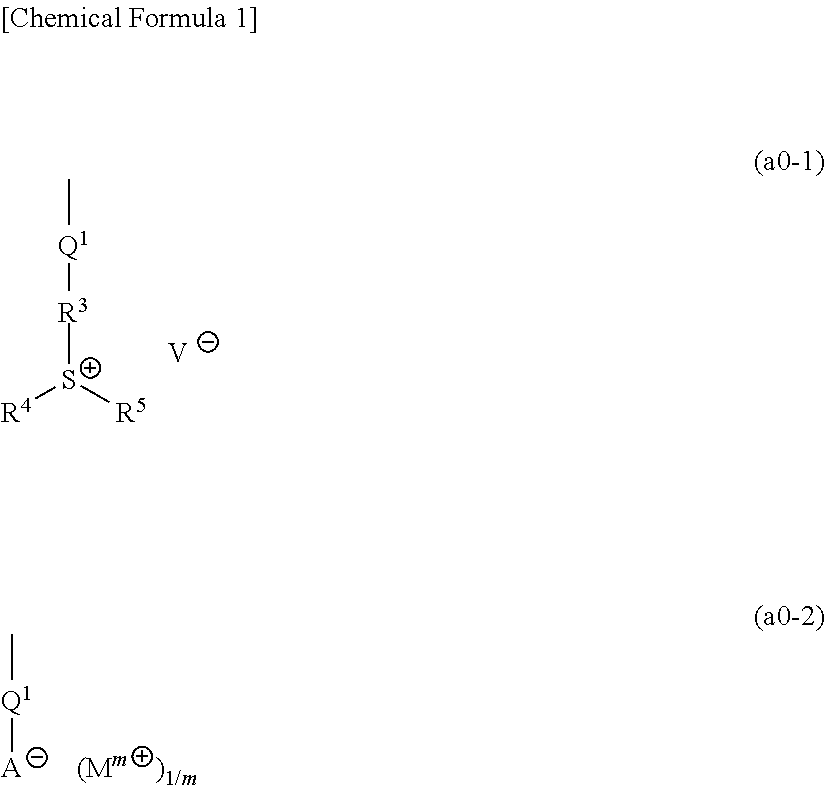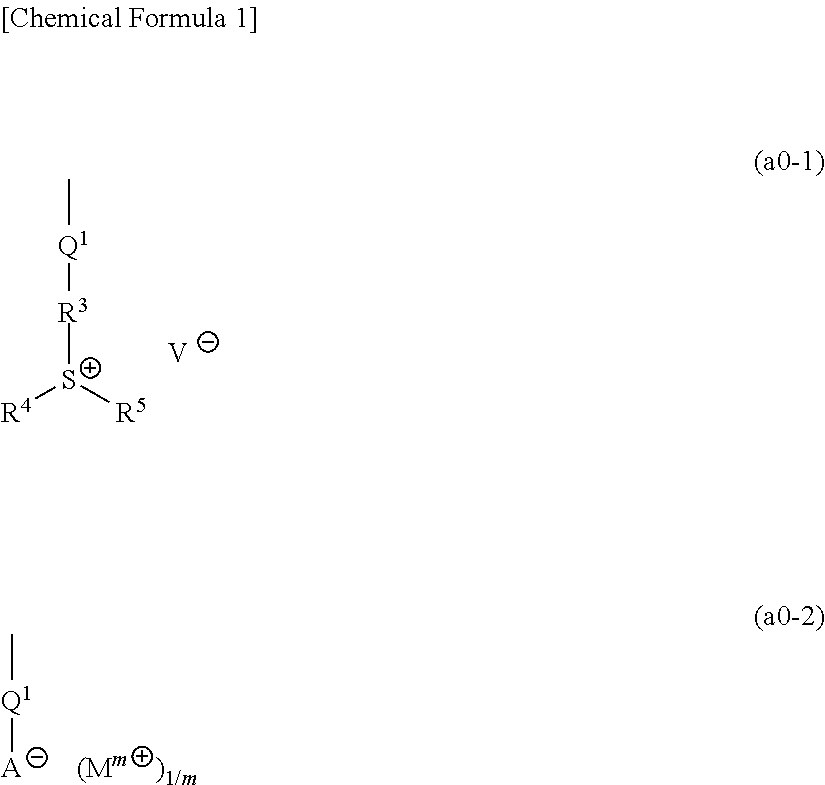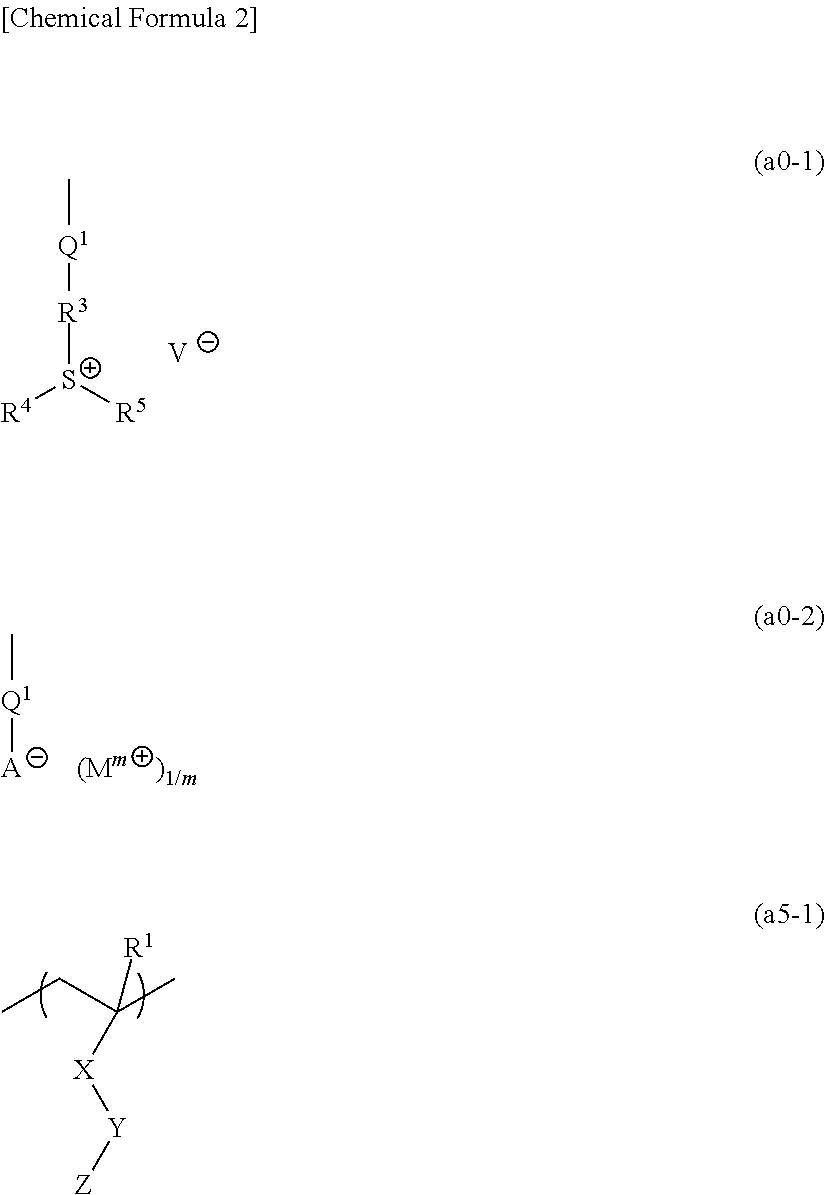Resist composition for EUV or eb and method of forming resist pattern
a composition and resist pattern technology, applied in the direction of photosensitive materials, photomechanical equipment, instruments, etc., can solve the problems of resist pattern thickness loss, resist pattern thickness loss at unexposed portions, lithography properties of resist pattern to be formed, etc., to achieve excellent lithography properties and excellent resolution
- Summary
- Abstract
- Description
- Claims
- Application Information
AI Technical Summary
Benefits of technology
Problems solved by technology
Method used
Image
Examples
examples
[1366]As follows is a description of examples of the present invention, although the scope of the present invention is by no way limited by these examples.
Polymer Synthesis Examples 1A to 20A
Synthesis of Polymeric Compounds 1A to 20A
[1367]Polymeric compounds 1A to 20A were produced by a normal method using monomers (1A) to (29A) corresponding to structural units constituting each polymeric compound. The polymeric compounds including structural units derived from monomers (4A) to (6A), (8A) to (14A), (19A) and (23A) were produced by porimerization using monomers (4A) to (6A), (8A) to (14A), (19A) and (23A) having a triphenylsulfonium as a countercation, and then conducting salt-exchange reaction by a normal method to replace the triphenylsulfonium with the predetermined countercation. The synthesis example of a precursor of the monomer (8A) used in the salt-exchange reaction will be described later.
[1368]Further, with respect to the obtained polymeric compounds, the compositional rat...
synthesis example
[1369]Under a nitrogen atmosphere, 4.3 g of the compound A was dissolved in 21.6 g of acetonitrile, and 2.0 g of heptahydrothiophene was added thereto in a dropwise manner, followed by stirring at 25° C. for 12 hours. Thereafter, the precipitated-white powder was separated by suction filtration, followed by washing with 11.3 g of acetonitrile, and then drying under reduced pressure, thereby obtaining 2.9 g of a precursor of the monomer 8A.
[1370]The obtained compound was analyzed by NMR, and the structure thereof was identified by the following results.
[1371]1H-NMR (400 MHz, DMSO-d6+D2O): δ(ppm)=5.1 (t, 2H, CH), 4.6 (t, 2H, CH), 4.3 (s, 1H, CH2), 3.9 (m, 3H, CH), 3.6-3.8 (t, 2H, SCH2), 3.4 (t, 2H, CH2), 2.9 (m, 5H, CH), 2.4 (4H, CH), 2.0 (t, 2H, CH2), 1.7-1.9 (m, 3H, CH2CH2), 1.2-1.4 (m, 4H, CH2CH2CH2)
TABLE 1Polymeric compound1A2A3A4A5A6A7A8A9A10AMonomer (1A)45454545444545454445 (2A)41414141424141414242 (3A)14 (4A)14 (5A)14 (6A)14 (7A)14 (8A)14 (9A)14(10A)14(11A)14(12A)13(13A)(14A)(1...
polymer synthesis example 2
[1399]Polymeric compounds 1B to 22B were produced by a normal method using monomers (1B) to (34B) corresponding to the structural units constituting each polymeric compound.
[1400]Further, with respect to the obtained polymeric compounds, the compositional ratio (the molar ratio of the respective structural units indicated in the structural formula shown below) as determined by carbon 13 nuclear magnetic resonance spectroscopy (600 MHz, 13C-NMR, internal standard: tetramethylsilane (TMS)), and the weight average molecular weight (Mw) and the molecular weight distribution (Mw / Mn) determined by the polystyrene equivalent value as measured by GPC are shown in Tables 7 to 9.
TABLE 7Polymeric compound1B2B3B4B5B6B7B8B9B10BMonomer (1B)454544454545 (2B)41414141414142414141 (3B)1414 (4B)1414 (5B)45454545 (6B)1414 (7B)1414 (8B) (9B)14(10B)14(11B)(12B)(13B)(14B)(15B)(16B)(17B)(18B)(19B)(20B)(21B)(22B)(23B)(24B)(25B)(26B)(27B)(28B)(29B)(30B)(31B)(32B)(33B)(34B)Mw1290012900131001300013100130001210...
PUM
 Login to View More
Login to View More Abstract
Description
Claims
Application Information
 Login to View More
Login to View More - R&D
- Intellectual Property
- Life Sciences
- Materials
- Tech Scout
- Unparalleled Data Quality
- Higher Quality Content
- 60% Fewer Hallucinations
Browse by: Latest US Patents, China's latest patents, Technical Efficacy Thesaurus, Application Domain, Technology Topic, Popular Technical Reports.
© 2025 PatSnap. All rights reserved.Legal|Privacy policy|Modern Slavery Act Transparency Statement|Sitemap|About US| Contact US: help@patsnap.com



